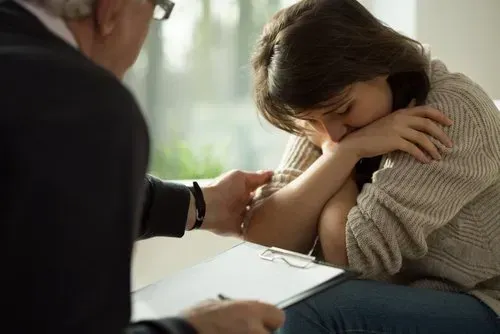Trauma and PTSD
in Lexington, Richmond & Frankfort KY
Have you experienced a traumatic event in your life that has impacted your daily living? Do you suffer from PTSD and often feel a sense of anxiety, panic, experience flashbacks, or memories that flood you and you feel vulnerable to that traumatic event again? If so, there is help for you.
Signs and Symptoms of Trauma
A trauma is the result of someone being exposed to an actual or real threat of death, serious injury, or sexual violence. This may entail experiencing the event themselves, witnessing a traumatic event occurring with another person, learning about a traumatic event happening to a close family member or friend, or repeatedly being exposed to disastrous traumatic events (e.g., social workers repeatedly investigating and witnessing child abuse, soldiers in combat, police officers repeatedly exposed to murders, violence, etc., first responders repeatedly collecting human remains.
Many great resources can be found at the National Institute of Mental Health at: http://www.nimh.nih.gov/health/publications/post-traumatic-stress-disorder-research-fact-sheet/index.shtml
Child Trauma
The National Child Traumatic Stress Network (NCTSN) at http://nctsn.org/trauma-types/early-childhood-trauma/Symptoms-and-Behaviors-Associated-with-Exposure-to-Trauma lists various symptoms that may be shown in children, who have been exposed to a traumatic event. A child may experience a trauma through physical, sexual, or emotional abuse, witnessing domestic violence, experiencing neighborhood violence (gangs), being involved or knowing another person has been in a near-fatal or fatal car accident, and many other instances. A child may exhibit symptoms, such as the following: Cognitive (has memory problems, demonstrates poor verbal skills, Behavioral (excessive temper, act out in social situations, startles easily, screams or cries excessively, fears being separated from parent/caregiver), and Physiological (may regress with potty training, wet the bed, experience headaches and stomachaches, poor sleep patterns).
Posttraumatic Stress Disorder (PTSD)
PTSD is a mental health diagnosis categorized in the Trauma and Stressor-Related Disorders. It often resembles anxiety, depression, panic attacks, helplessness, worry, fear, problems with memory, exaggerated startle response, sleep disturbances, flashbacks, nightmares, angry outbursts, intense emotions, or avoidance strategies. These symptoms have to be present for longer than a month to meet the criteria for PTSD.
http://www.nimh.nih.gov/health/topics/post-traumatic-stress-disorder-ptsd/index.shtml
Treatments that can make a difference
The person experiencing PTSD would benefit from seeing a qualified mental health therapist. A Licensed Professional Counselor (LPCC), a Licensed Clinical Social Worker (LCSW), a Licensed Marriage and Family Therapist (LMFT), or a Psychologist are all trained mental health professionals that provide counseling to both children and adults, who are experiencing PTSD. An individual would work with their therapist on establishing a treatment plan that works best for the client.
The following are treatment interventions for PTSD:
Prolonged Exposure (PE) involves having the client tell the story of the trauma memory in detail, along with thoughts and emotions, from beginning to end. And then tell it again, and again... The theory is that as avoidance of the memory is prevented, the client has a chance to learn that it can no longer hurt, and desensitization occurs. This is an effective, well-researched treatment, mainly for adults.
Cognitive Processing Therapy (CPT) is an exposure variant that involves having the client write down the trauma memory rather than speak it; the writing may provide some distance, making the procedure more tolerable. Most of the research on CPT has been with adult victims of rape, but one study of incarcerated teens with PTSD also showed CPT's effectiveness.
Trauma-Focused Cognitive-Behavioral Therapy (TF-CBT) is a treatment for children that involves having the child create a book of the trauma memory, in which each page of the book represents one significant part of the event. The drawing helps to hold the child's interest, while going only a page at a time breaks down the memory into small parts, so that facing it is more tolerable. This method is well tolerated by children and well researched. The goal is for the child to create a narrative (through drawings, writings, other creative measures), which is sometimes in the form of a book, after learning coping skills to process their story with their therapist.
Narrative Exposure Therapy (NET) begins by creating a graphic time line of the client's life, marking all of the best and worst events along the way. Then the worst events are addressed sequentially using narrative exposure (basically PE). NET has been found to be rather efficient with children as well as adults, perhaps because the broader life perspective from the time line has been structured in.
Traumatic Incident Reduction (TIR) involves having the client imaginally view a "movie" of the trauma memory, and then discuss it with the therapist. This is repeated until no further distress is reported. TIR could use more research but appears to be efficient and well tolerated by children as well as adults.
Eye Movement Desensitization & Reprocessing (EMDR) involves having the client concentrate on the worst part of the memory for perhaps half a minute at a time, while moving his or her eyes back and forth by following the therapist's moving fingers. This is done again and again until all distressing aspects of the memory have been worked through. The brief burst of exposure, combined with the distraction of the eye movements, may help to make the procedure more tolerable. This web site features a lot of information on EMDR, because it is well researched, effective, well tolerated, and has been found to be more efficient than the traditional exposure methods (such as PE, TF-CBT).
Counting Method (CM) involves having the client visualize a "movie" of the trauma memory, from beginning to end, while the therapist counts out loud from one to one hundred. The visualization, time limit, and distraction of the counting may help to make the procedure more tolerable. In the one controlled study completed so far, CM appeared to work as well and as quickly as EMDR (PE took about 50% longer for the same results). It has so far been used only with adults.
Progressive Counting (PC) is a variant of the counting method, developed by Dr. Greenwald, designed to make the treatment more efficient and better tolerated by clients. PC involves having the client visualize a series of progressively longer "movies" of the trauma memory while the therapist counts out loud first from one to 10, then to 20, then 30, etc. PC appears to be at least as effective as EMDR, well tolerated by clients, more efficient, and relatively easy for therapists to learn. PC is now featured in many of our training programs.
Structured Play Therapy is a structured, directive style of play therapy that guides the child to repeatedly go through the trauma memory, in symbolic form. This is not a manualized treatment approach like the others on this page, and the research supporting this approach is not as strong as for most of the others listed. Even so, it is a legitimate and potentially effective way of conducting "exposure" with a child.
Long Term Successes and Ways to Get Help
If you have experienced a traumatic event and are experiencing the symptoms of PTSD, there is help for you. Working alongside a qualified mental health professional and focusing on traumatic triggers, coping skills, cognitive (thinking) distortions, telling your story via a narrative, and building a relationship with a therapist can significantly reduce and even end the intrusive feelings and flashbacks associated with PTSD. Instead of avoiding the thoughts and feelings associated with the traumatic event(s), a therapist will encourage you to remember the event, process it, address your feelings when the event occurred, and begin to incorporate purposeful coping skills to decrease the intense emotions and thoughts of PTSD.
Here are tips and suggestions to help with your own healing or the healing of a loved one with PTSD: http://www.helpguide.org/articles/ptsd-trauma/post-traumatic-stress-disorder.htm
Seeking treatment for PTSD is easy. Select a professional , we recommend a psychologist, LPCC or LCSW first, and have an assessment performed. They may refer you to a psychiatric ARNP or a psychiatrist for a medication evaluation and or prescribe a course of treatment. If you need help, call us at 859-338-0466 or contact us today!
Make an appointment with a dedicated staff member in order to start your healing process.
Please see the Counseling Process section for more details on scheduling your visit.
- Darby Creek Lexington, KY 501 Darby Creek Road, Lexington, KY, United States
- Duval Street Location Lexington, KY 1092 Duval Street, Lexington, KY, United States
- Frankfort, KY 105 Diagnostic Dr, Frankfort, KY 40601, United States
- 1043 Center Dr, Richmond, KY 40475, United States 1043 Center Dr, Richmond, KY 40475, United States








